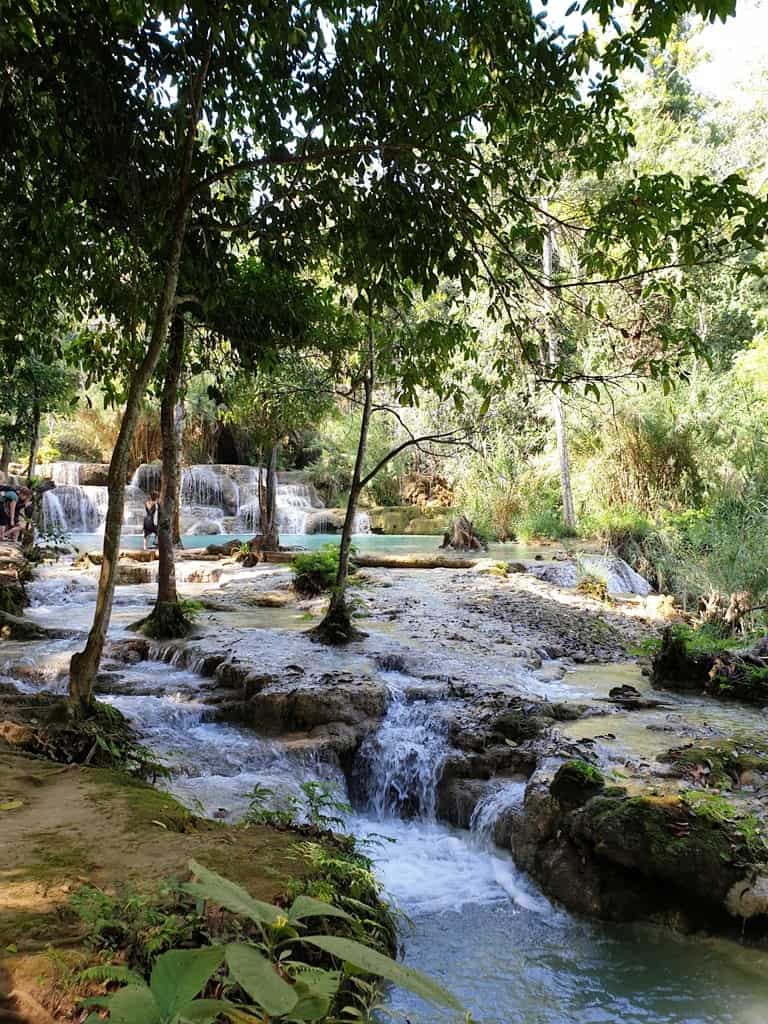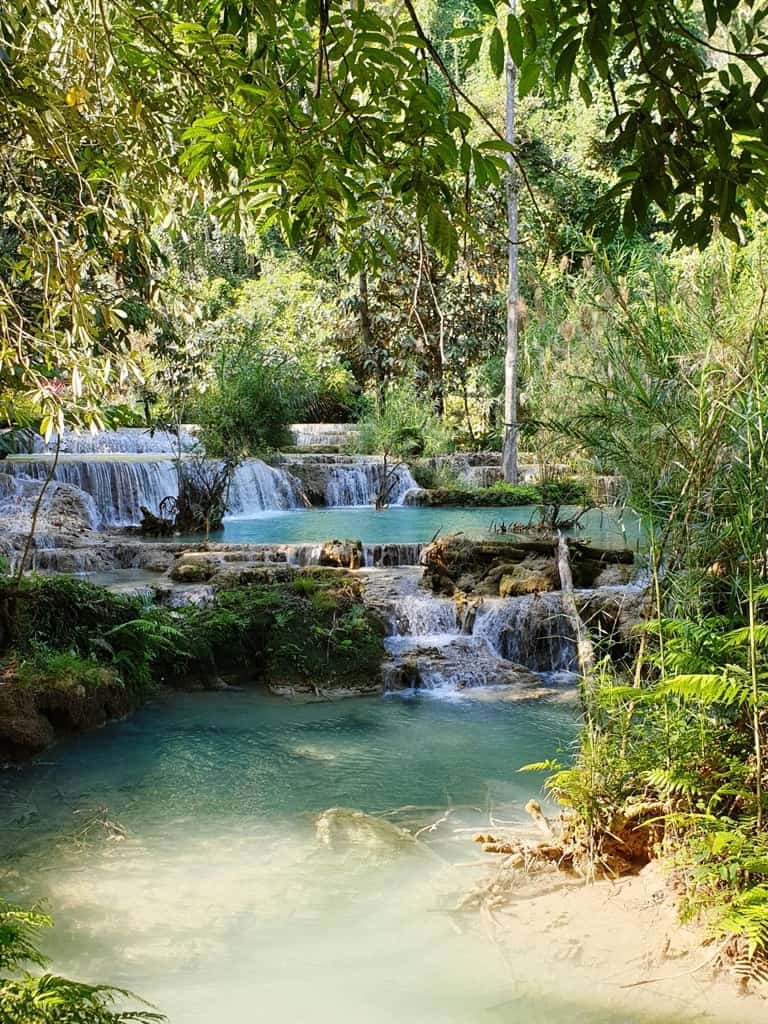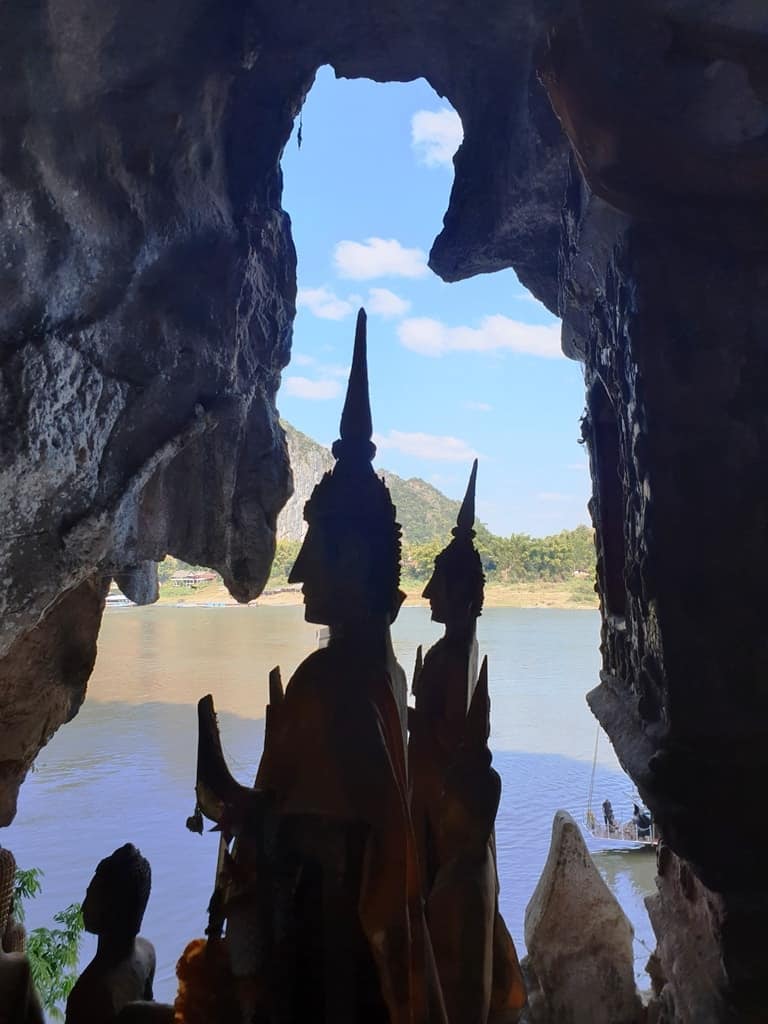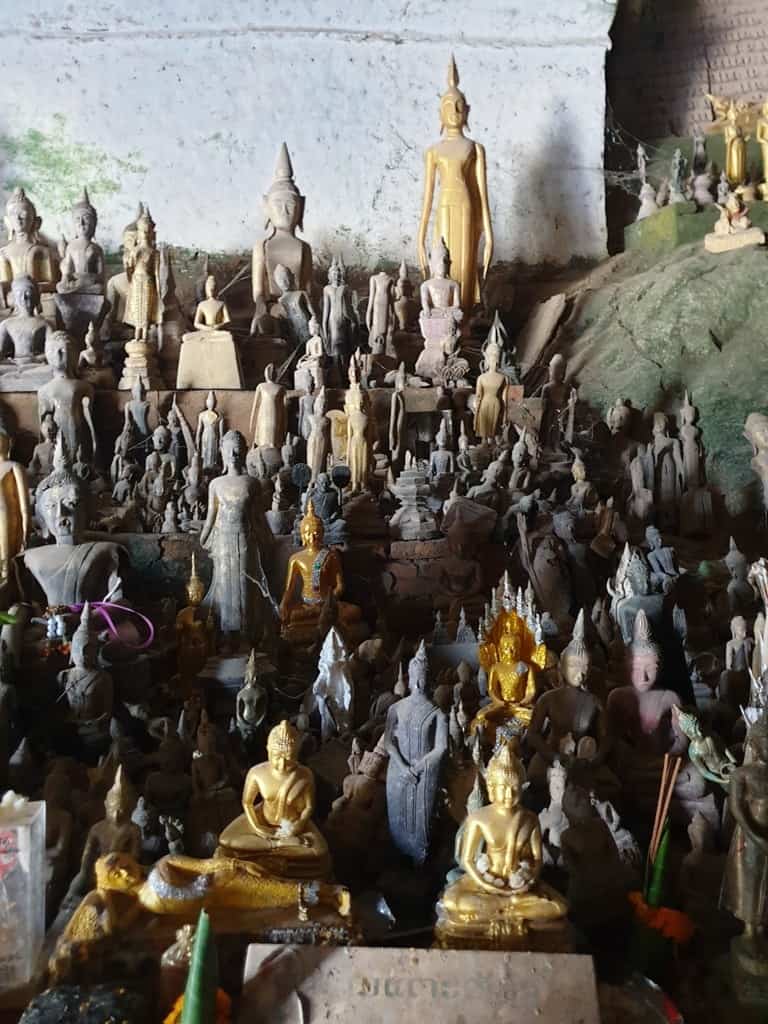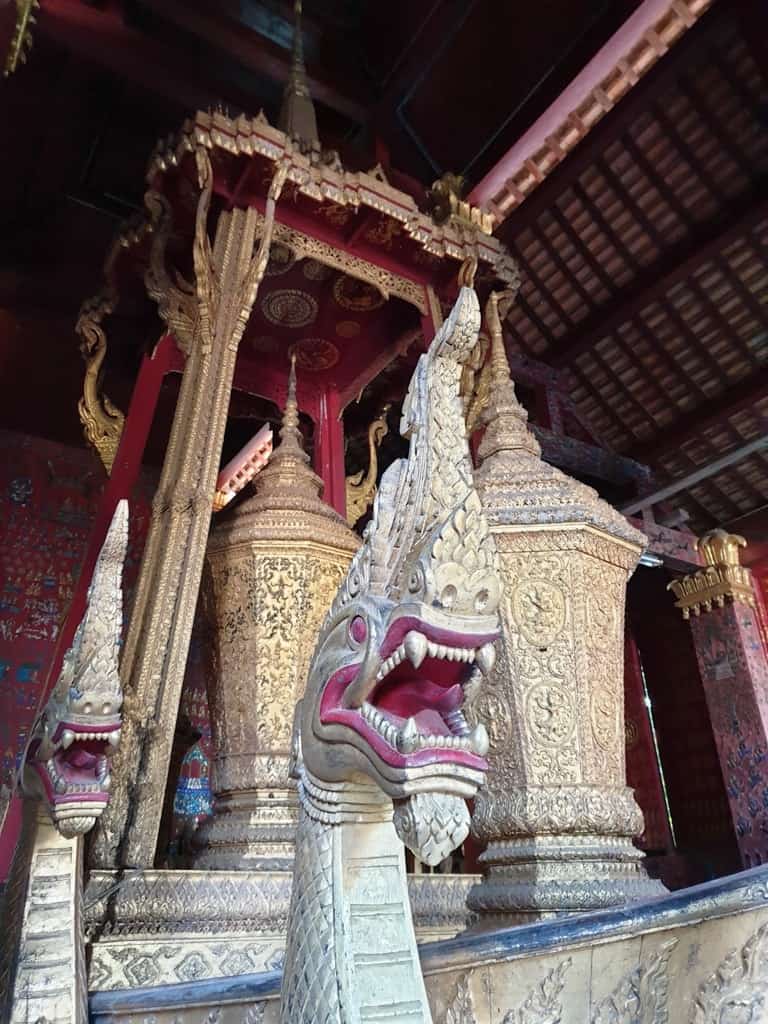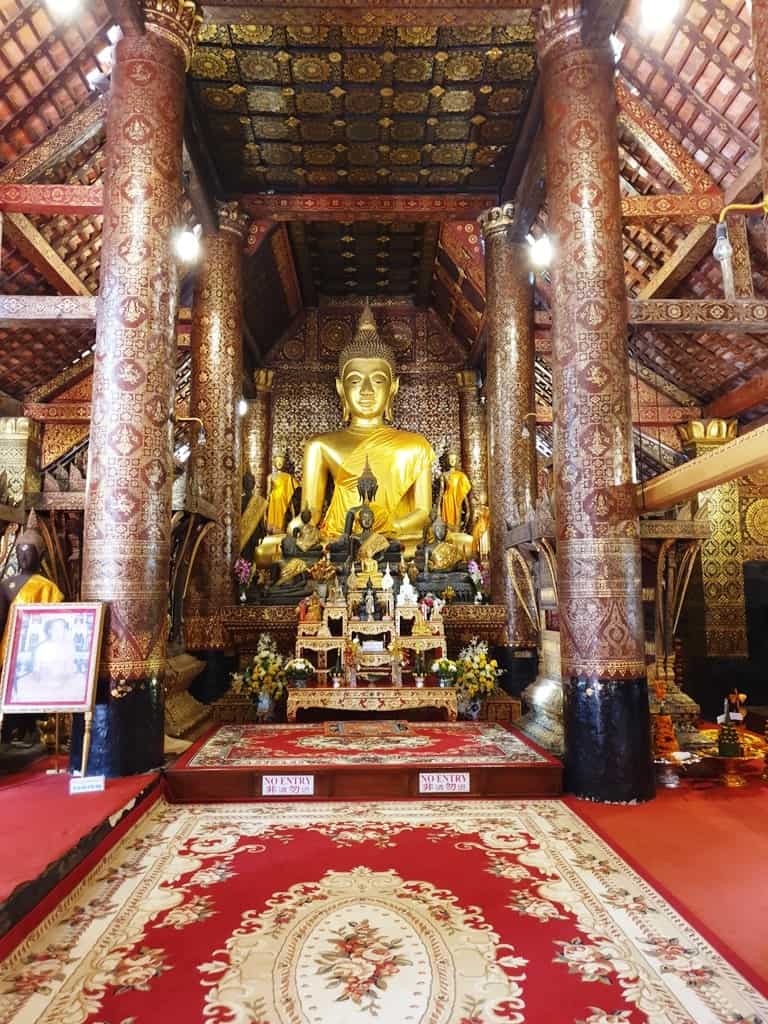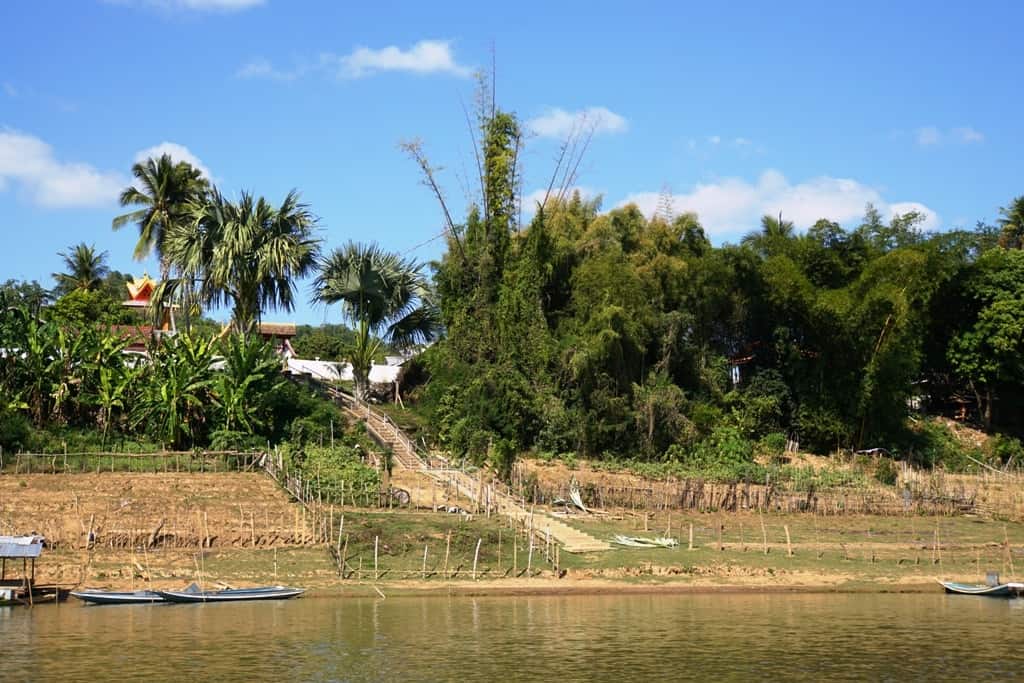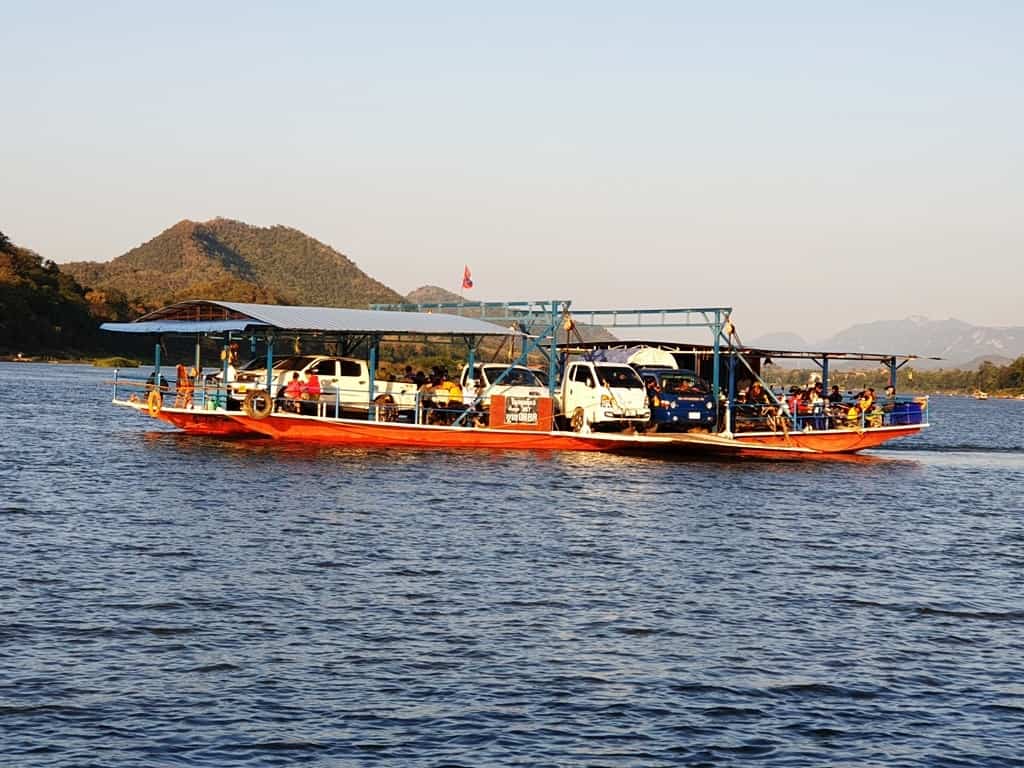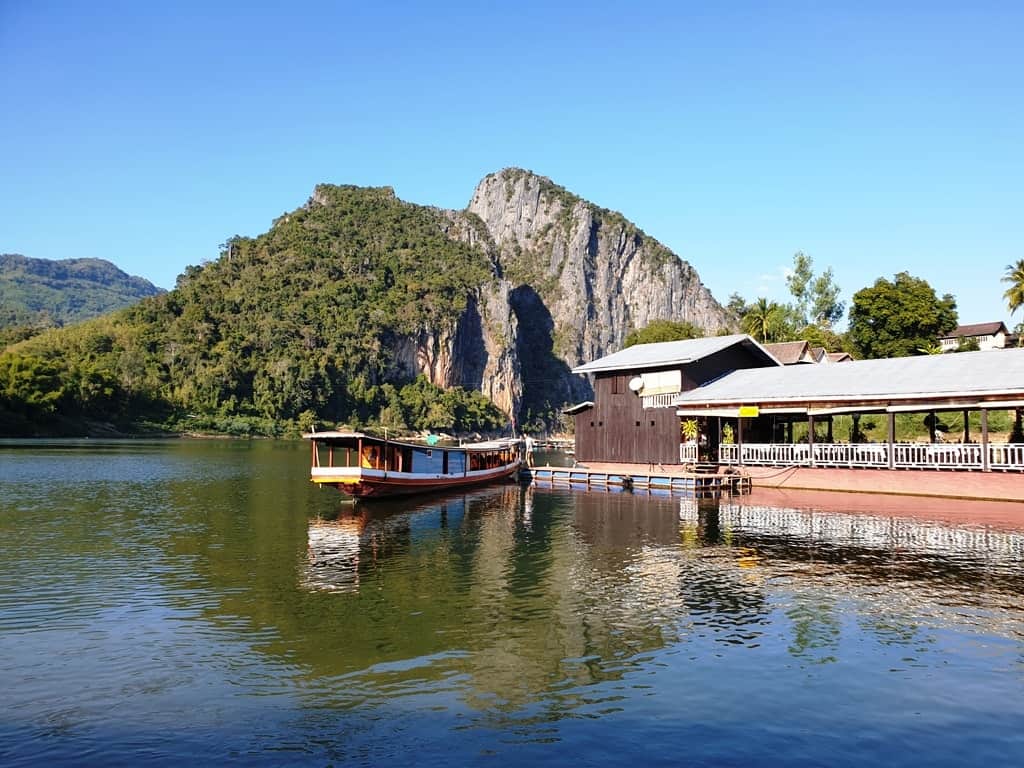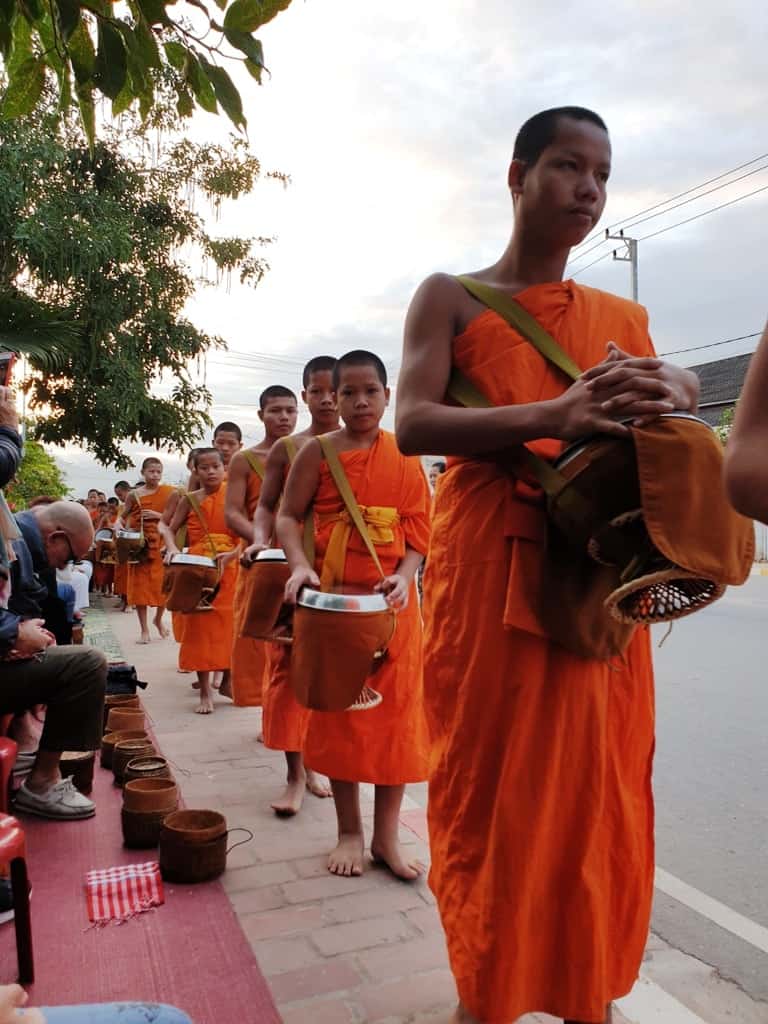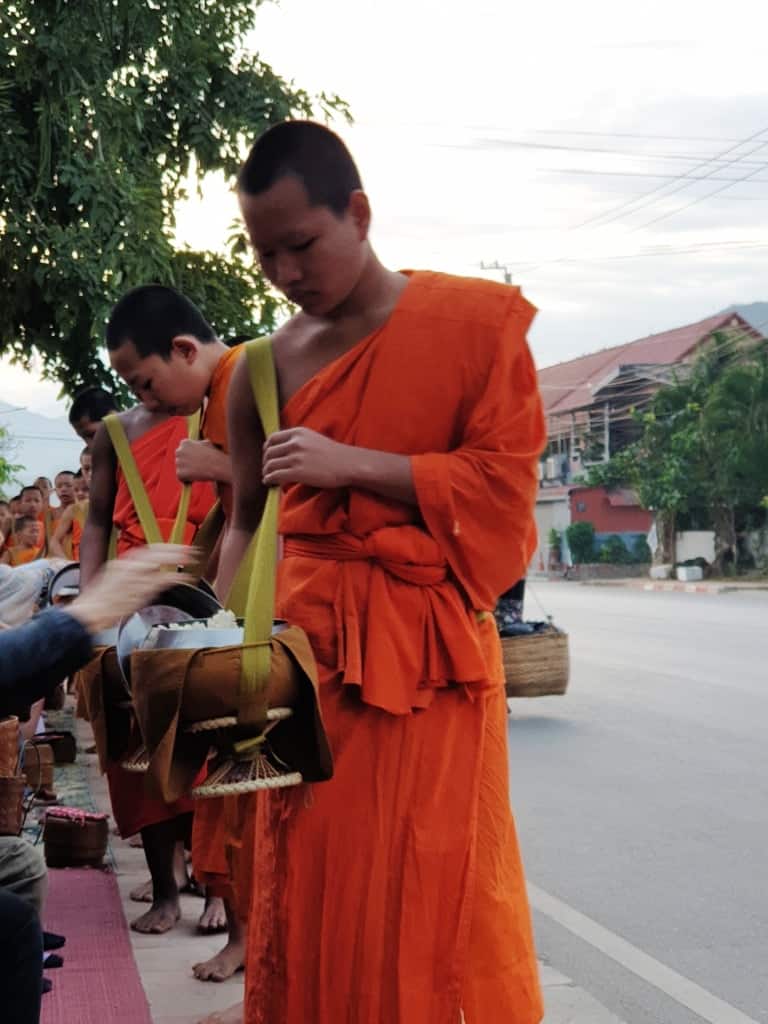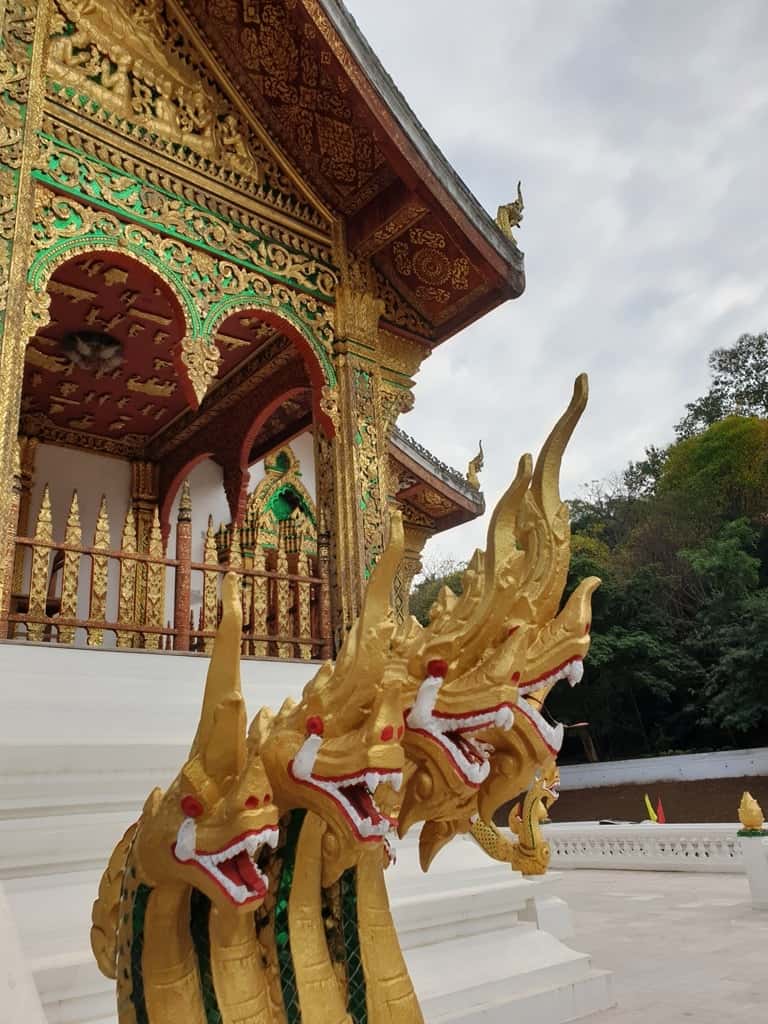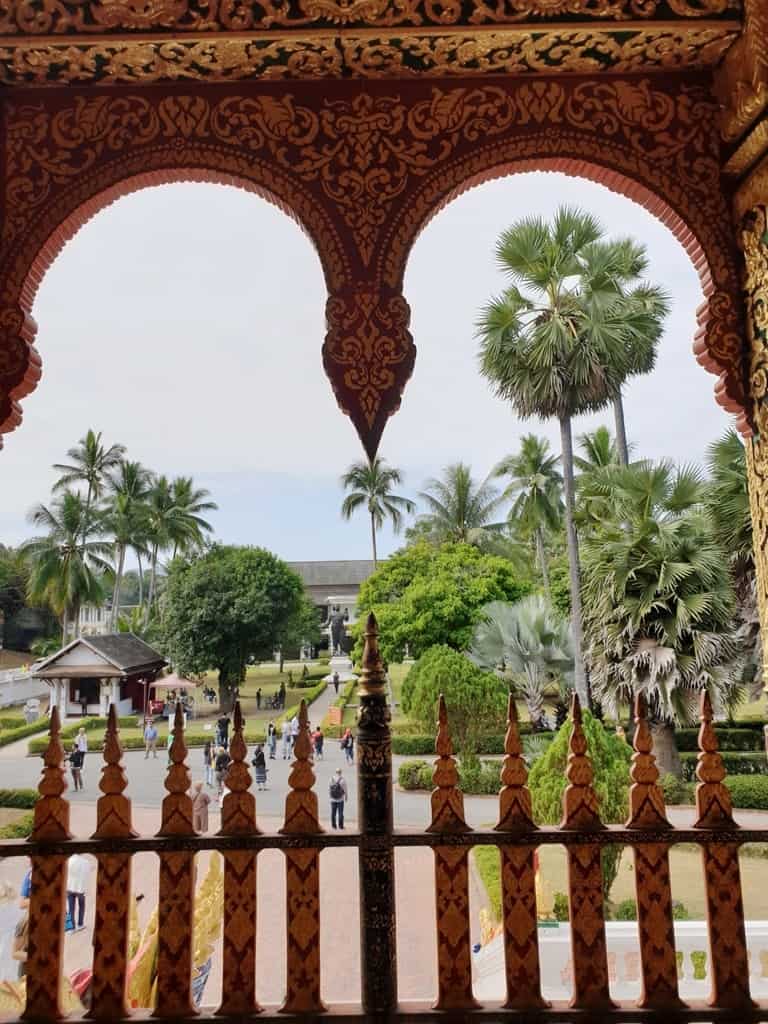This post is also available in: French
The UNESCO World Heritage Site of Luang Prabang is a charming city that is a delight for both the soul and the senses, with exquisite temples, bustling markets, peaceful, robed monks meandering through the streets, and gentle colonial influences that give it an eclectic mix of Asian and European heritage. Unlike other larger Asian cities, Luang Prabang has more of a village feel, with locals and tourists walking and cycling around the temple and market-laden streets.
Not only does Luang Prabang offer a whole host of sights and attractions for travelers, but it also serves as a fantastic base for exploring some of the region’s natural wonders such as waterfalls, caves, and rivers. Read on to discover my top tips about where, when, and how to travel to Luang Prabang so that you make the most of your time in this incredible Asian destination.
Table of Contents
When Is The Best Time To Visit Luang Prabang?
As Laos is a tropical country, it has two distinct seasons, the wet and dry seasons. Generally speaking, the dry season in Laos runs from October to April and the wet season from May to September. While this isn’t an exact science, you can typically expect the wettest weather during the months of August and September, so these are best avoided if you don’t want to experience tropical downpours.
However, if you don’t mind a bit of rain here and there you can pretty much travel to Luang Prabang at any time of year. April, May, and June offer the hottest temperatures in Luang Prabang, with daily highs usually climbing into the 30s!
Thankfully for us, Luang Prabang tends to receive the lightest rainfall, with most downpours occurring during the night or early morning, so these can usually be avoided leaving the rest of the day to explore.
If you like warm, dry days then you’re best off visiting Luang Prabang during November or between March and May.
Disclaimer: This post contains affiliate links. This means that should you click on certain links, and then subsequently purchase a product, I will receive a small commission.
What To Do In Luang Prabang
Kuang Si Waterfalls
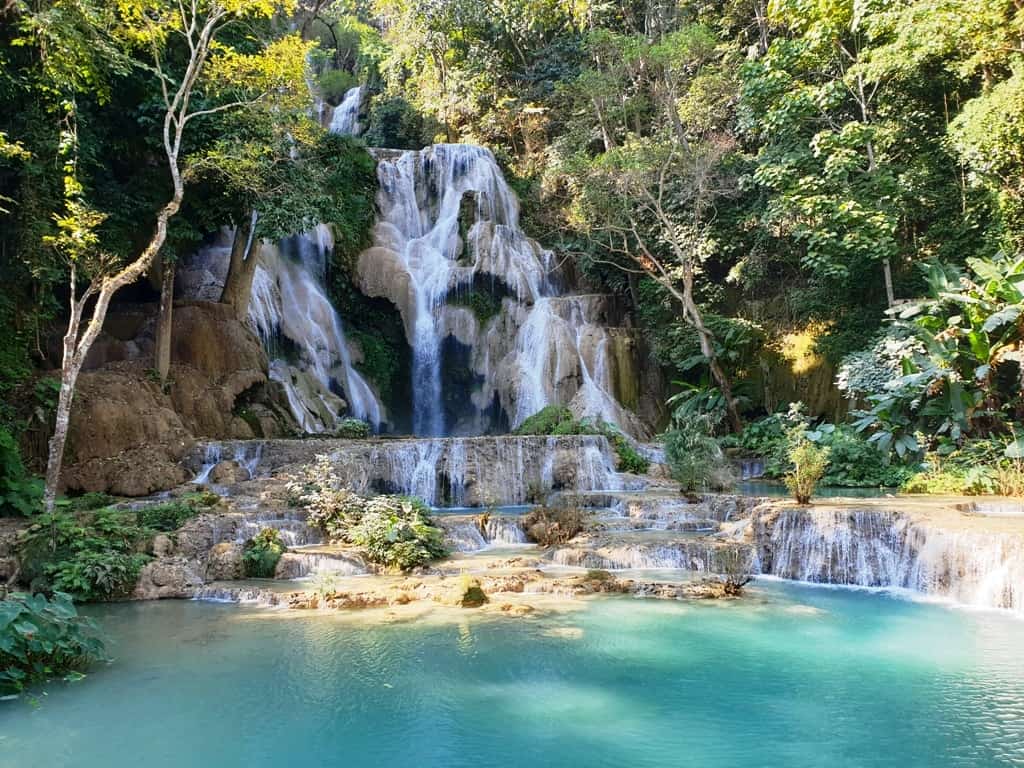
Kuang Si or Kuang Xi waterfalls are situated around 30km south of Luang Prabang and are one of the highlights of any trip to the region. The waterfall complex here spreads over three levels, with tumbling water and cooling pools making it the perfect place to relax. The tallest of the waterfalls stands proud at 60m high (200ft) and flows down the rock face towards the tranquil turquoise pool at the bottom.
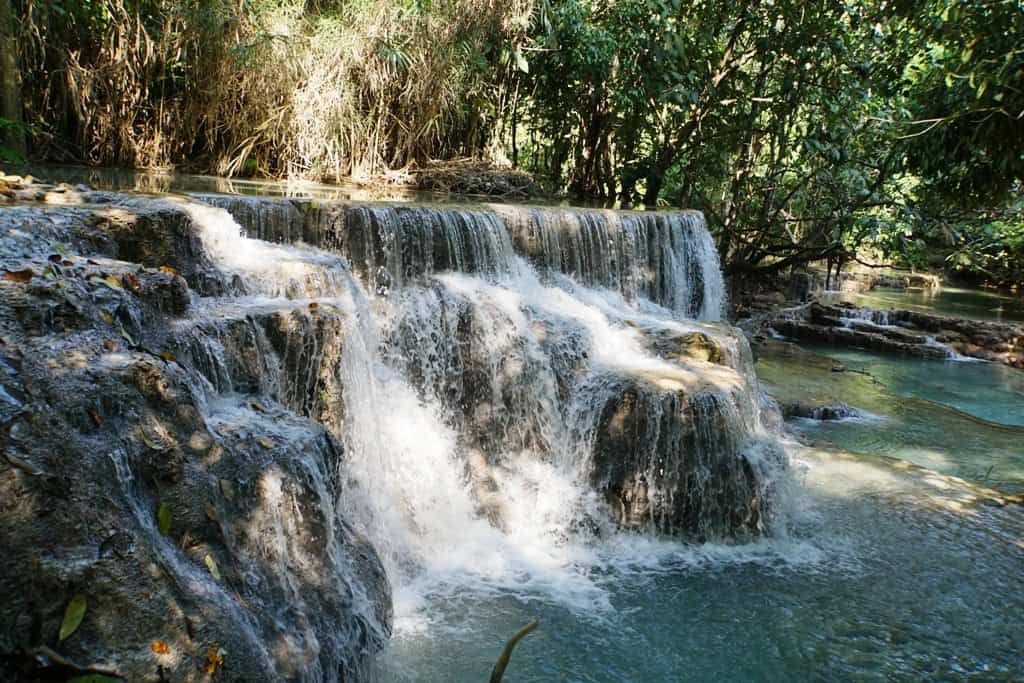
The Kuang Si falls are fairly easy to reach from Luang Prabang, with regular day trips being offered by a variety of tour companies in the city. Alternatively, you could just take a taxi to the falls, giving you more flexibility as to when you come and go. Entrance to the falls costs just 20,000 kip (just over $2) which is fantastic considering they are so well maintained.
As the waterfalls are so beautiful they are often busy (especially during peak season) but if you visit early or late in the day you’re more likely to have a peaceful experience than if you visit at lunchtime.
Visit the Pak Ou Caves
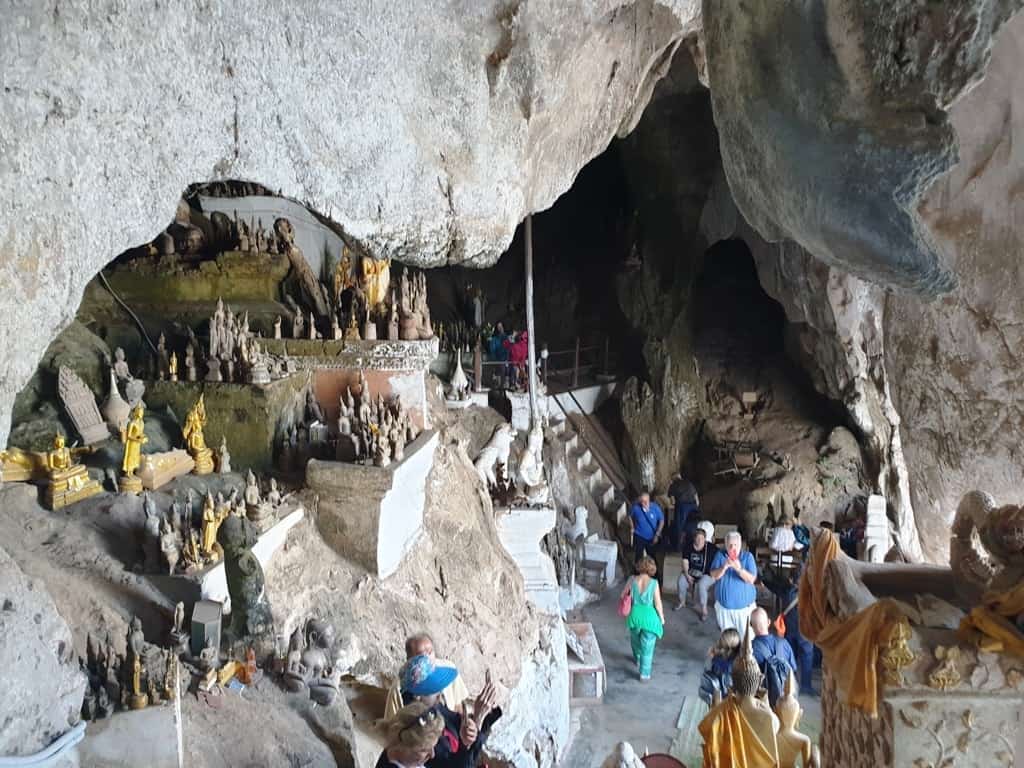
Another fantastic day trip from Luang Prabang is the Pak Ou Caves which are located around 25km north of the city. These caves are perfectly placed to overlook the Mekong River and feature hundreds if not thousands of wooden Buddha statues in various states of disrepair. Each of the Buddha statues represents a different belief or action, with some meditating, others teaching and some even reclining representing reaching the stage of enlightenment or nirvana.
Visitors can reach the caves by driving or by boat and you can easily combine a trip with a visit to the wine and whiskey-producing Ban Xang Hai or a Mekon cruise.
Book a day trip to Pak Ou Caves, Whisky Village & Kuang Si Falls
Watch The Sunset From Mount Phou Si
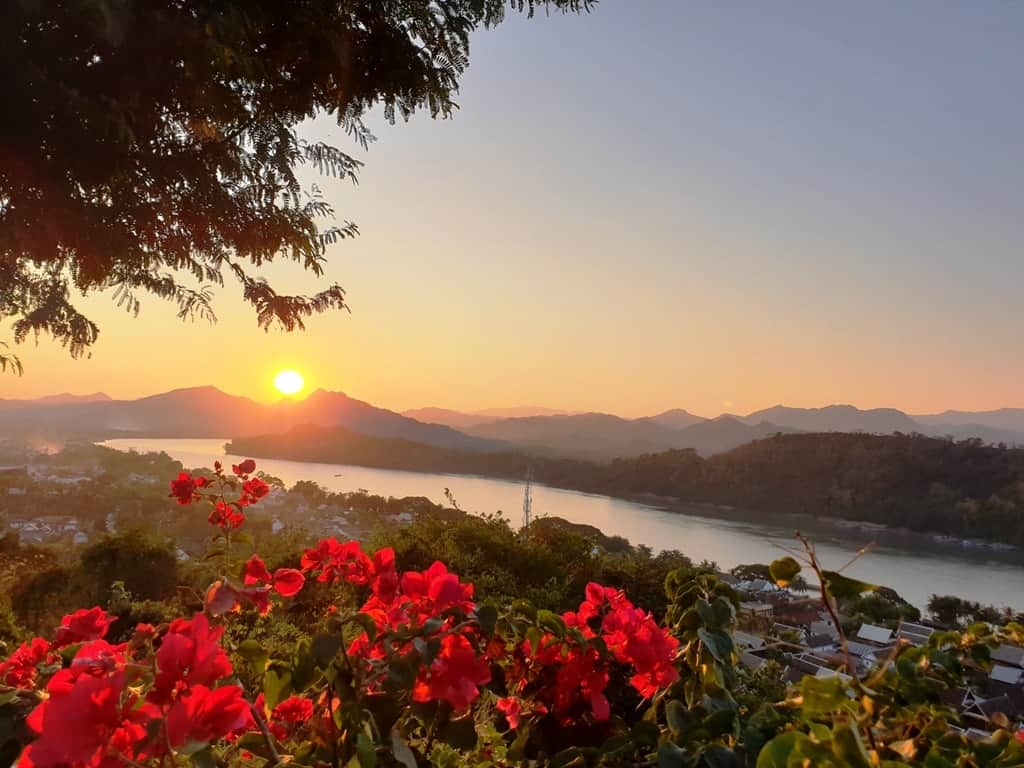
Mount Phou Si is a 100m high hill that rises above the center of Old Town Luang Prabang and is one of the best places in the city to watch the sunset. On a clear day, you can witness panoramic views of the Mekong on one side of the city and the Nam Khan River on the other, with the tops of the Buddhist temples spread out in between.
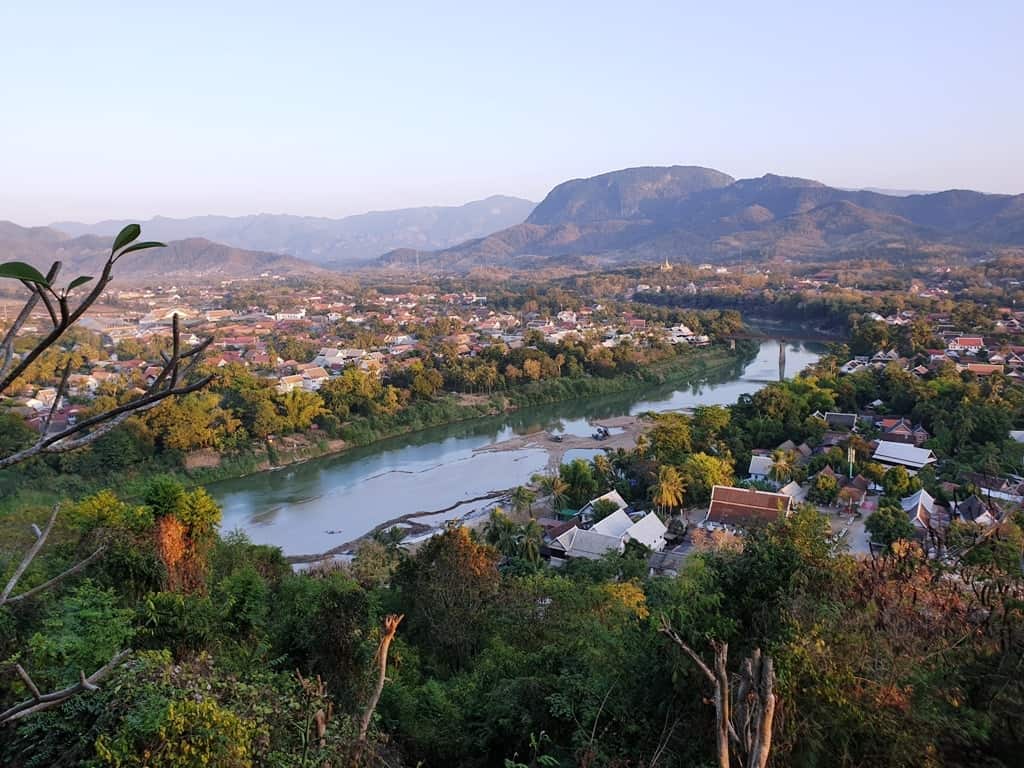
Each evening hundreds of travelers head up the hill in order to watch the skies turn orange as the day moves to night, perhaps stopping off at Wat Tham Phou Si, a Buddist temple on the way up. This is a great place to get an idea of the size and scenery of Luang Prabang so I highly recommend doing this on your first evening if you get the chance.
Wat Xieng Thong

There are many temples in Luang Prabang that are well worth visiting and Wat Xieng Thong Temple is arguably one of the most beautiful and important in the city. Wat Xieng Thong roughly translates as the Temple of The Golden City which makes sense when you start exploring the site and discover the gilded golden stupa above the main door, the gold-colored Buddha statues within the temple and the glistening gold door of the funeral chapel. Wat Xieng Thong was built between 1559 and 1560 when Luang Prabang was the royal capital of the kingdom.
Today Wat Xieng Thong remains in remarkable condition, with regular restorations taking place to ensure the architecture, design, and heritage are protected.
Wat Mai Suwannaphumaham
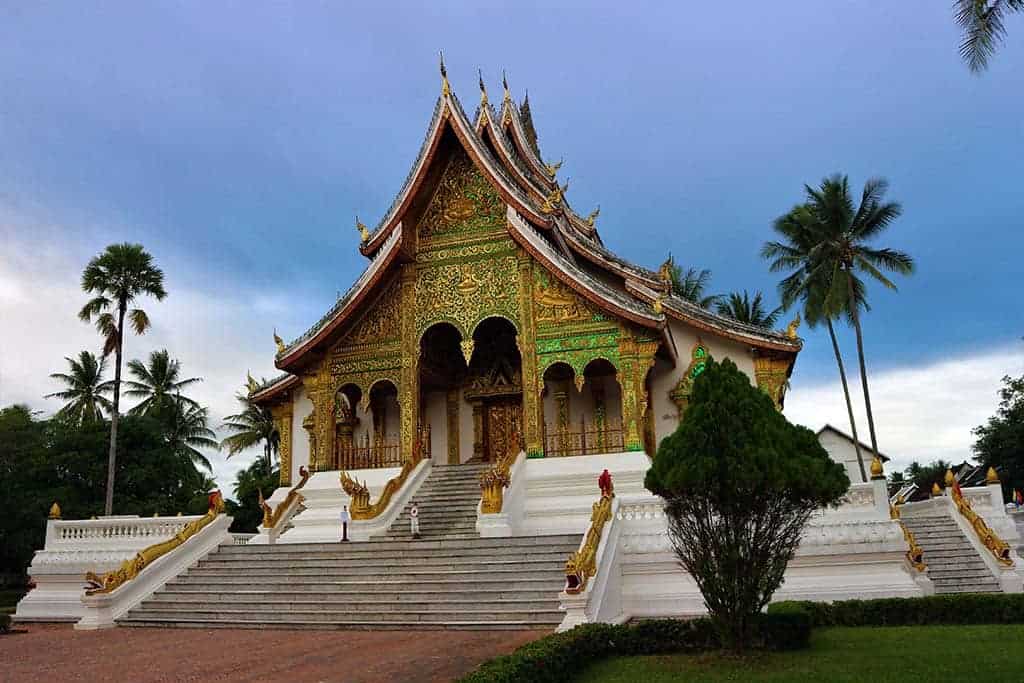
Another important temple to visit in Luang Prabang is Wat Mai Suwannaphumaham, the largest and most exquisite of all the temples in the city. Wat Mai Suwannaphumaham (often simply called Wat Mai) was built in the 18th century and is famed for housing an emerald Buddha statue as well as featuring a stunning sǐm (ordination hall) with a complex five-tiered roof.
The fact that Wat Mai Suwannaphumaham was spared by gangs in the late 19th century because they thought it to beautiful to harm just goes to show how impressive this building is and why it’s well worth a visit!
Wat Sen
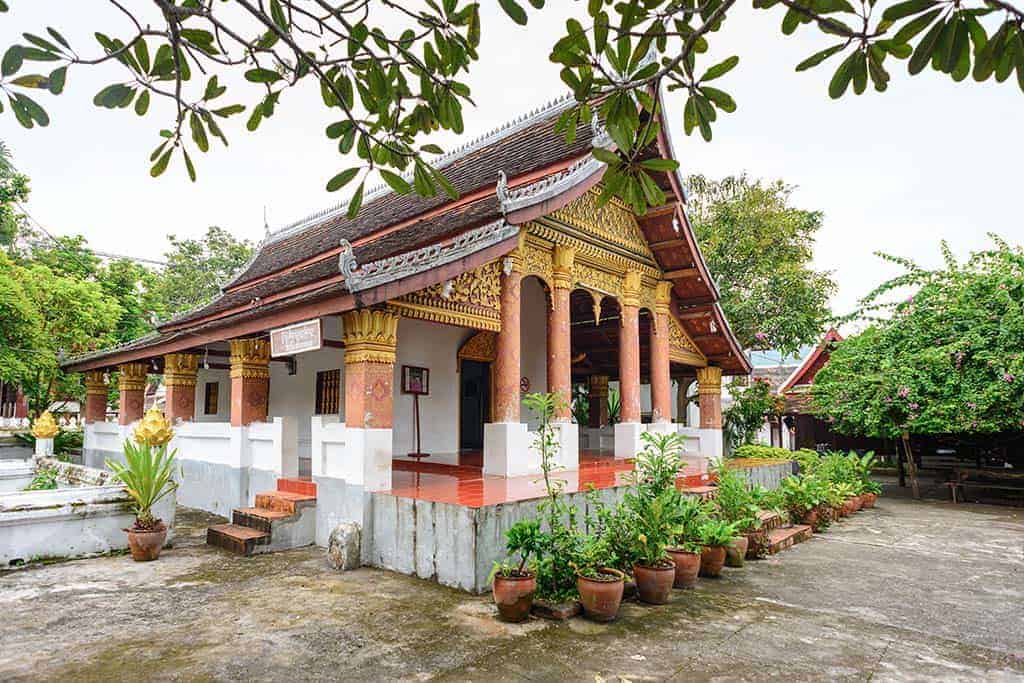
Wat Sen Souk Haram (usually just referred to as Wat Sen) is yet another exquisite temple complex that features intricate facades, rich red roofs and golden statues and pagodas throughout. Known as the Temple of a Hundred Treasures, Wat Sen was thought to have been built in 1718 with an initial donation of 100,000K – around $10USD in today’s money! While that doesn’t sound like much it would have been a decent donation way back then and with regular restoration work being completed on the temple it still remains a beautiful work of Buddhist architecture today.
Take a Cruise Down The Mekong
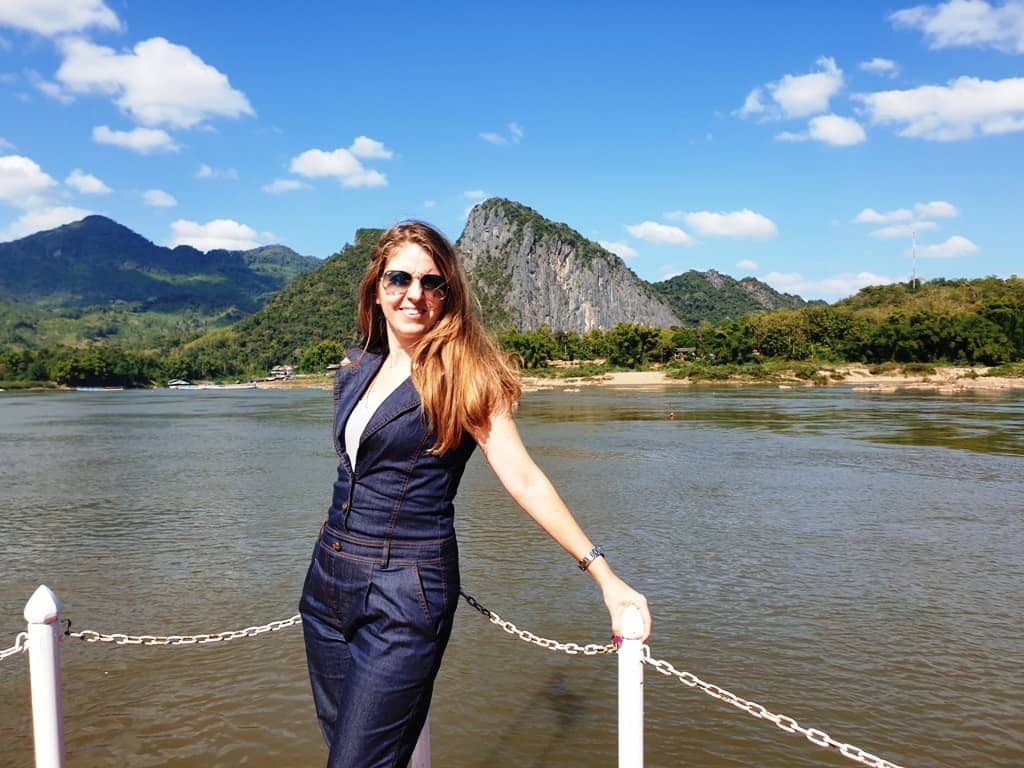
One of the ways many people choose to arrive in Luang Prabang is to take a slow boat down the Mekong from Thailand to Laos, a journey that allows you to soak up the views of the region at a leisurely pace. Even if you arrive by plane in Luang Prabang, you can still enjoy the vistas by taking a cruise down the Mekong from the city.
Luang Prabang is located on the confluence between the Mekong and the Khan rivers which made it an important trade location as well as being a royal and religious capital. There are still many rural communities that live along the Mekong River which can be seen as you travel downstream and you’ll often be greeted by children who stand on the riverbanks waving as boats that pass by!
Visit the Night Market
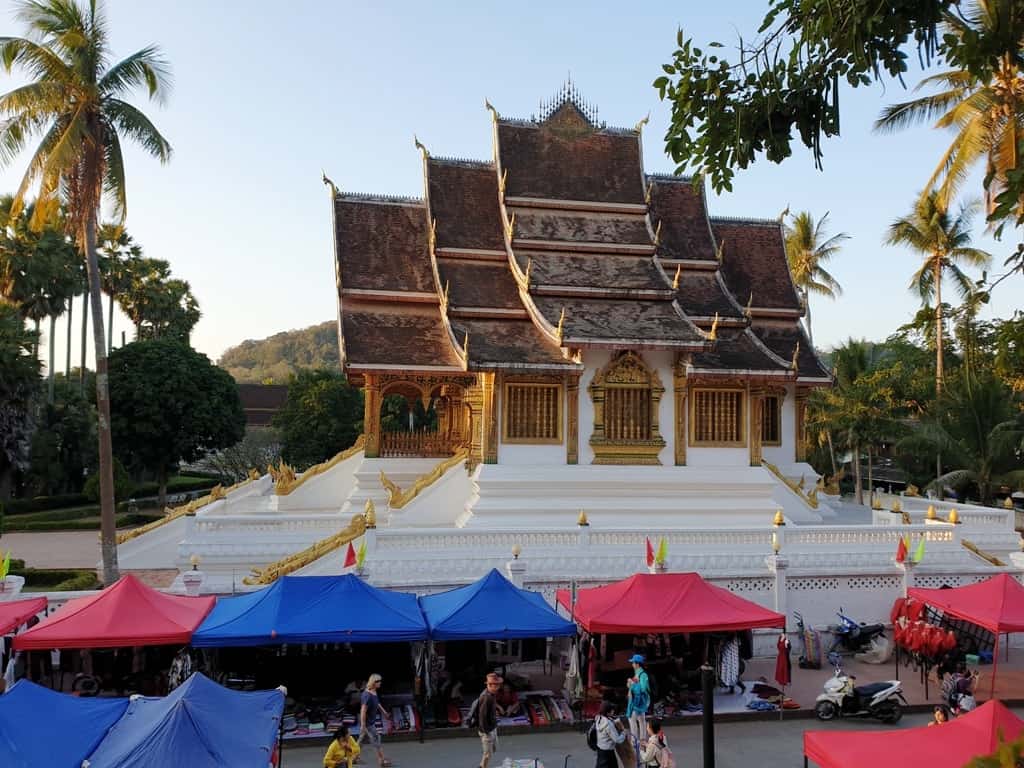
Once you’ve watched the sunset over the city from Mount Phou Si, you’ll want to check out the night market that sprawls through the streets of Luang Prabang. This buzzing market consists of locals selling their wares from small mats and stalls, with everything from lampshades and local artwork to silk scarves and souvenirs being on offer.
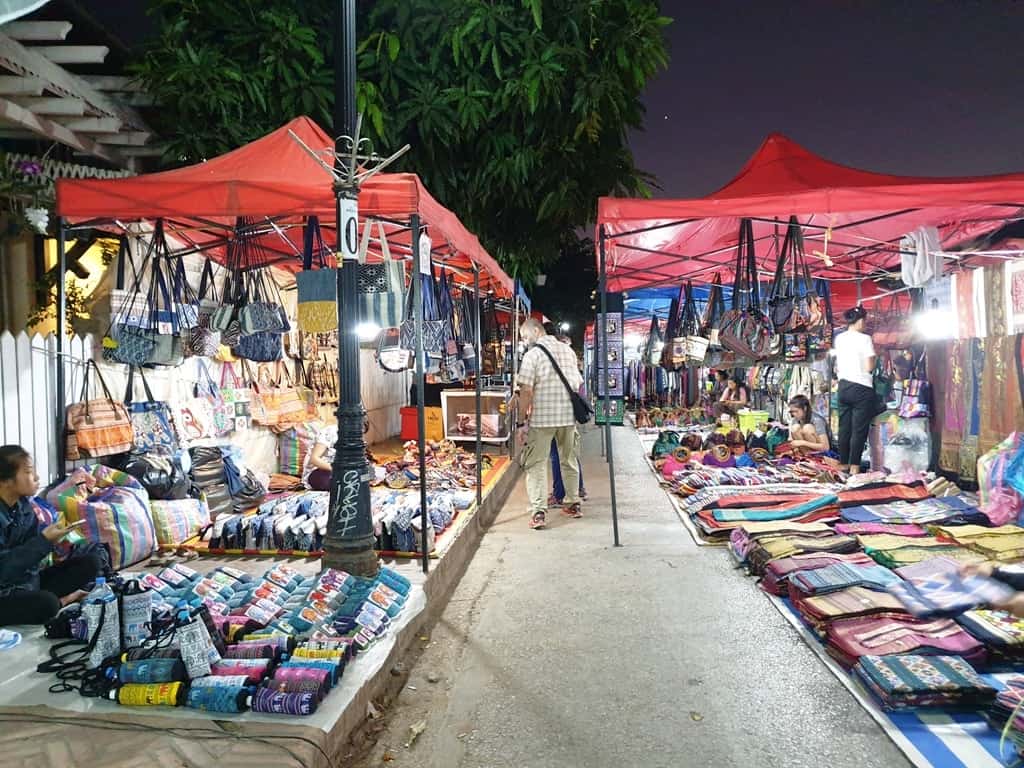
The Night Market started as a way for local people to provide tourists the chance to buy handmade crafts before Christmas back in 2002, and as it was such a success it never stopped! Travelers can, therefore, peruse the stalls every night from 5 pm.
Check Out The Food Markets
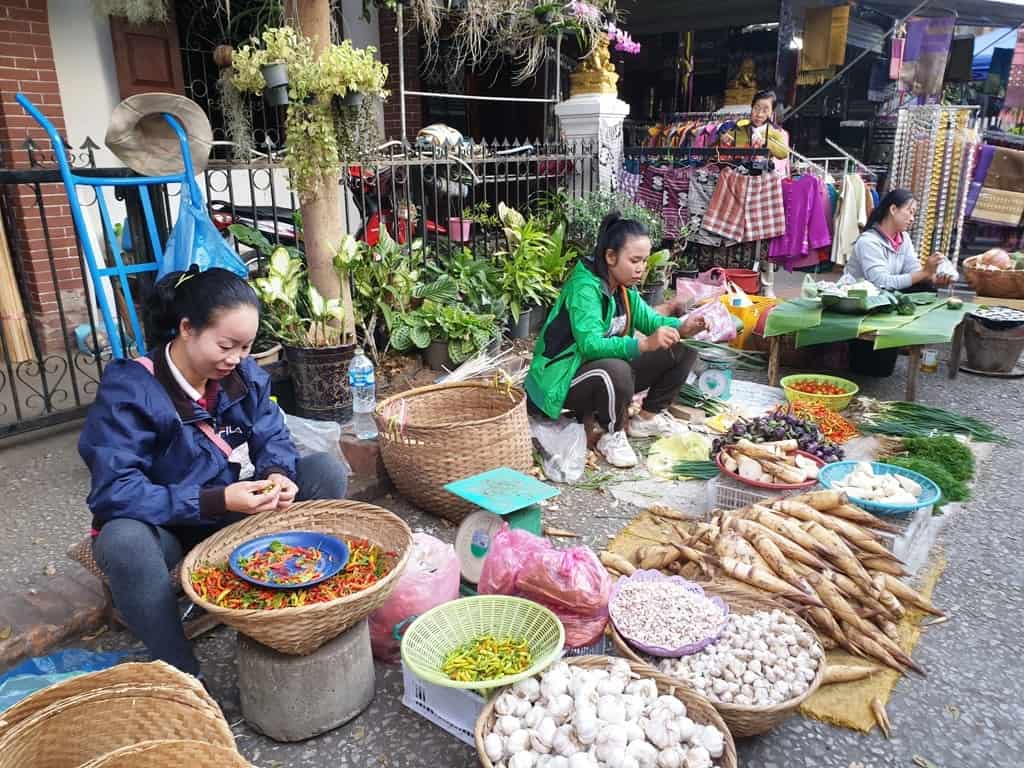
If you want to pick up snacks and street food from the night market then you’re in luck as there is a whole section of vendors serving up hot and cold food and drinks. This area is sometimes referred to as the Caterer’s Evening Market and features Asian favorites like barbecued meat, noodle soup, papaya salad, and spring rolls. This makes the perfect pit-stop during your rounds of the market stalls and is a cheap alternative to eating out.
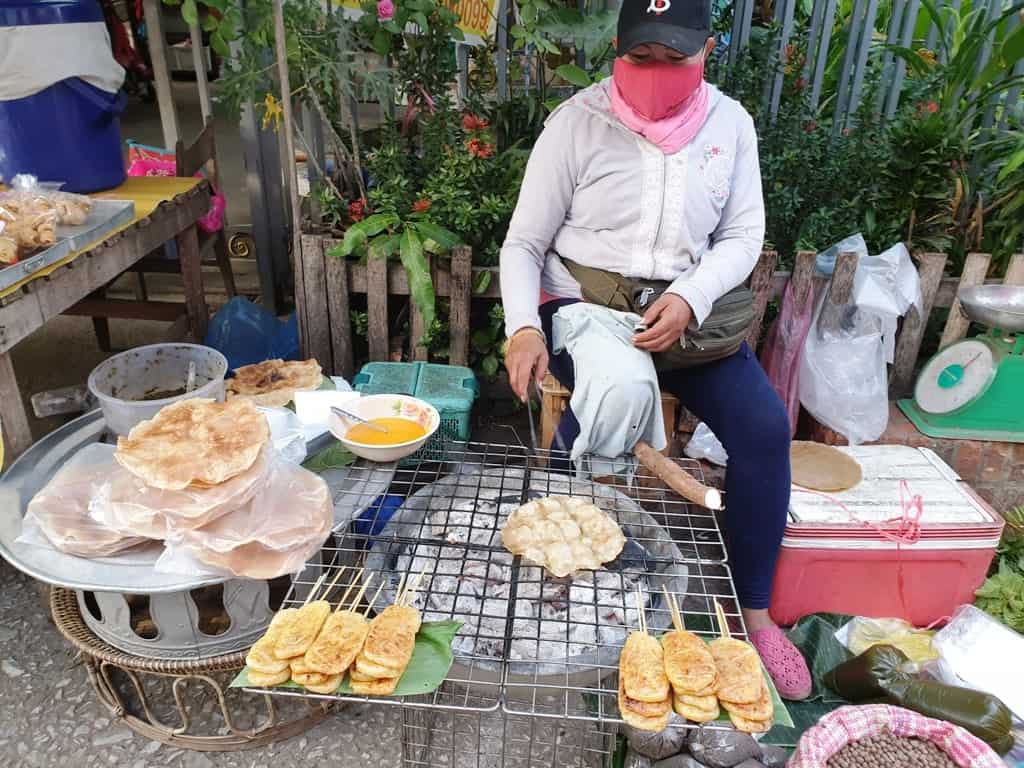
If you want a more authentic food market experience or would like somewhere to pick up fresh produce, then you’ll want to check out Luang Prabang’s morning market that lines a few of the streets near the Royal Palace. This market starts early and is usually over by mid-morning so you’ll want to choose a morning where you’ve not been on the Lao Lao Whisky the night before!
If nothing else, the morning market is a fascinating insight into what fresh and live produce is available in Asia, as you’re likely to see everything from fish, frogs, and grilled insects to a wide array of colorful fruit and green vegetables.
Take Part In The Alms-Giving Ceremony
The alms-giving ceremony is probably one of the most famous things to see and do in Luang Prabang and as it happens every day, there’s no excuse not to go. Well, apart from the fact that it starts around sunrise, I suppose, but I still think it’s worth getting up for!
The alms-giving ceremony takes place on the main street of Luang Prabang and is essentially a procession of saffron-robed monks from the local temples taking to the street in order to receive alms (virtuous offerings), usually in the form of rice. This offering will then serve as their daily meal.
While most of the people who offer alms are local, there is no reason why you should not be able to take part, as long as you are aware of the local etiquette and are happy to sit throughout the whole procession. If you do wish to take part it is advised that you arrive early (as interrupting once it has started is considered very rude) and that you are quiet and don’t take photos. You can ask your hotel to prepare some steamed rice for you to take to the ceremony or pick up some fresh fruit or traditional snacks.
If you’d rather just watch the procession, please ensure that you stand an appropriate distance away and remain respectful.
Visit The Royal Palace Museum
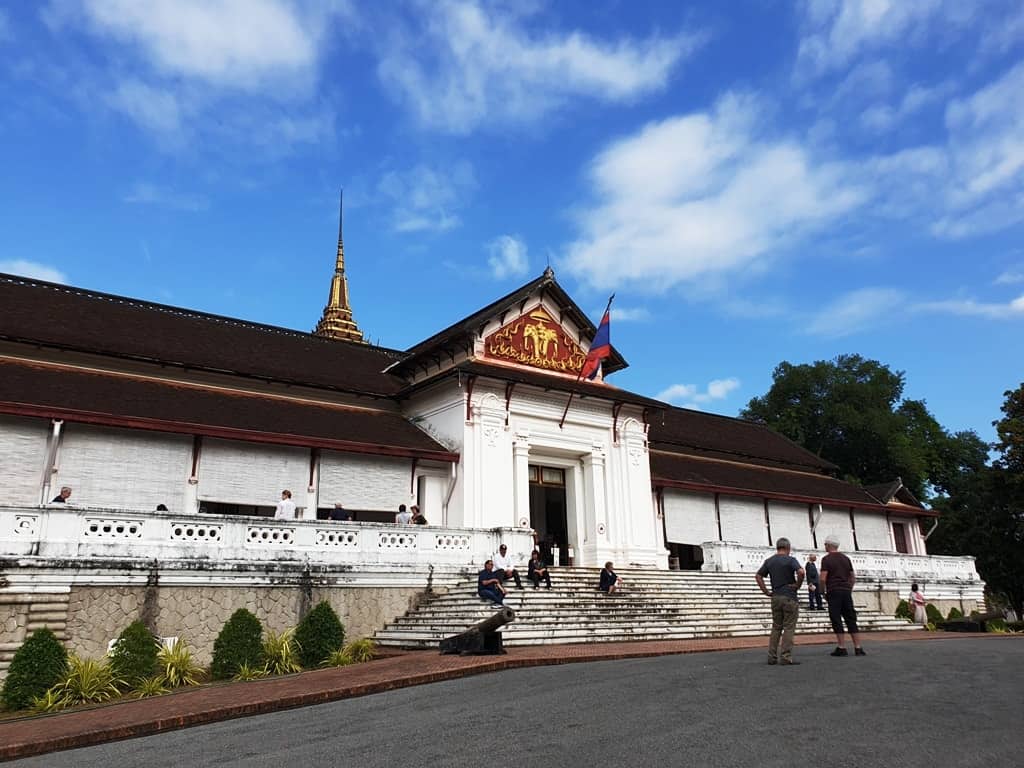
If you want to learn a bit more about Luang Prabang’s history and culture you should visit the Royal Palace Museum, a building that was built in the French Beaux-Arts style during the colonial era with many accents of traditional Lao culture. This design in itself offers quite an insight into the history of the city, and the museum exhibits of religious objects, weapons, paintings and even the crown jewels add to the depiction of Luang Prabang’s past.
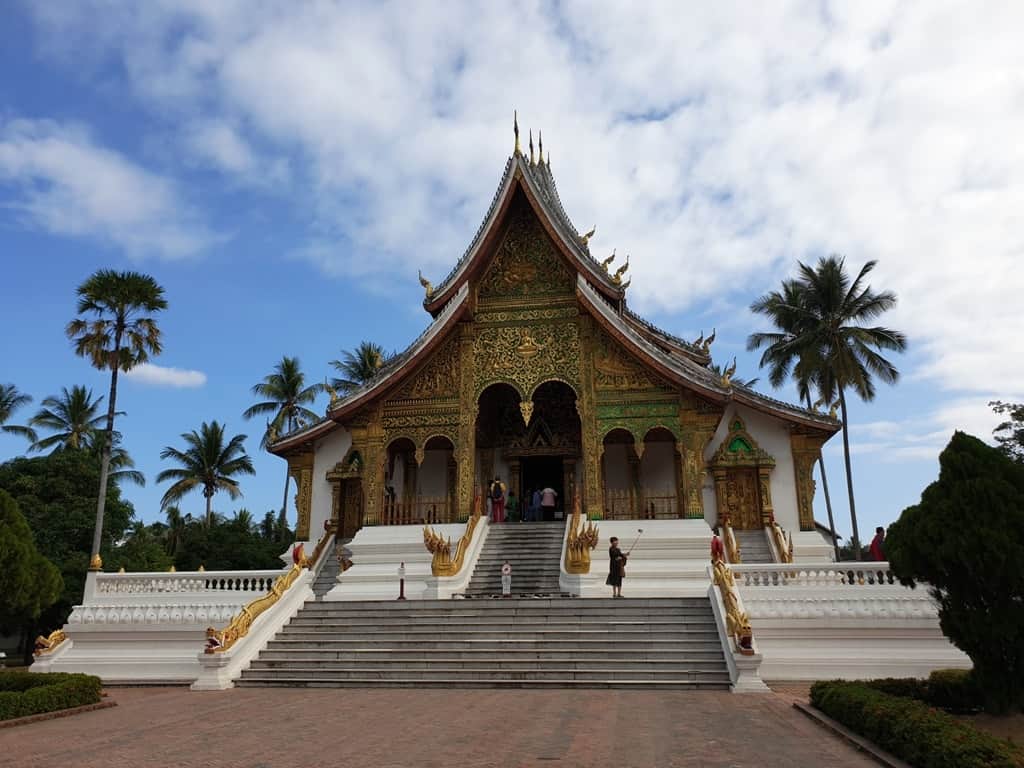
The Royal Palace Museum pavilion also houses the 2000-year-old Prabang Buddha which the city is named after, which is made from solid gold!
While it’s good to visit the Royal Palace Museum during the day, you can also head here at night to witness traditional dance performances.
Have A Traditional Massage
Traveling to Asia without having a traditional massage is like going to London and not seeing Buckingham Palace, so make sure you make time to seek one out during your stay in Luang Prabang. There are many different massage parlors and spas throughout the city, offering different services at a whole range of prices.
You can opt for an aromatherapy oil (Western-style) massage or try a more authentic Lao-style massage that focuses on pressure points using techniques more similar to reflexology and acupuncture. These massages can be quite intense and may feel a little uncomfortable, to begin with, but if you can relax into it, you’ll really feel the benefits afterward!
Take A Cooking Class
Another great experience I had while traveling in Luang Prabang was taking a Hmong Vegetarian Cooking Class. This class allowed me and my group to get a taste of traditional Laotian food, specifically Hmong, while also learning how to recreate this at home.
Our class involved going to a local person’s home and seeing how they cook in a traditional kitchen with traditional ingredients. Our guide helped us to create two vegetarian dishes, along with three delicious dipping sauces, using large wooden chopping boards, a ceramic mortar, and an open fire.
The food tasted fresh, light, and flavorsome and I’d highly recommend this experience to any foodies seeking an authentic cookery experience.
Click here for more information and to book a cooking class.
Where To Stay In Luang Prabang
Luang Prabang has a huge range of accommodation options, with everything from simple guesthouses and budget backpacker hostels, to luxury hotels and spa resorts. Therefore, even the most discerning traveler is well catered for and you’re sure to find something to suit your taste and budget. During my recent trip to Laos, I was lucky enough to stay in the boutique Villa Santi Hotel & Resort, a complex that combines bungalows, suites, and hotel rooms in lush, tropical surrounds.
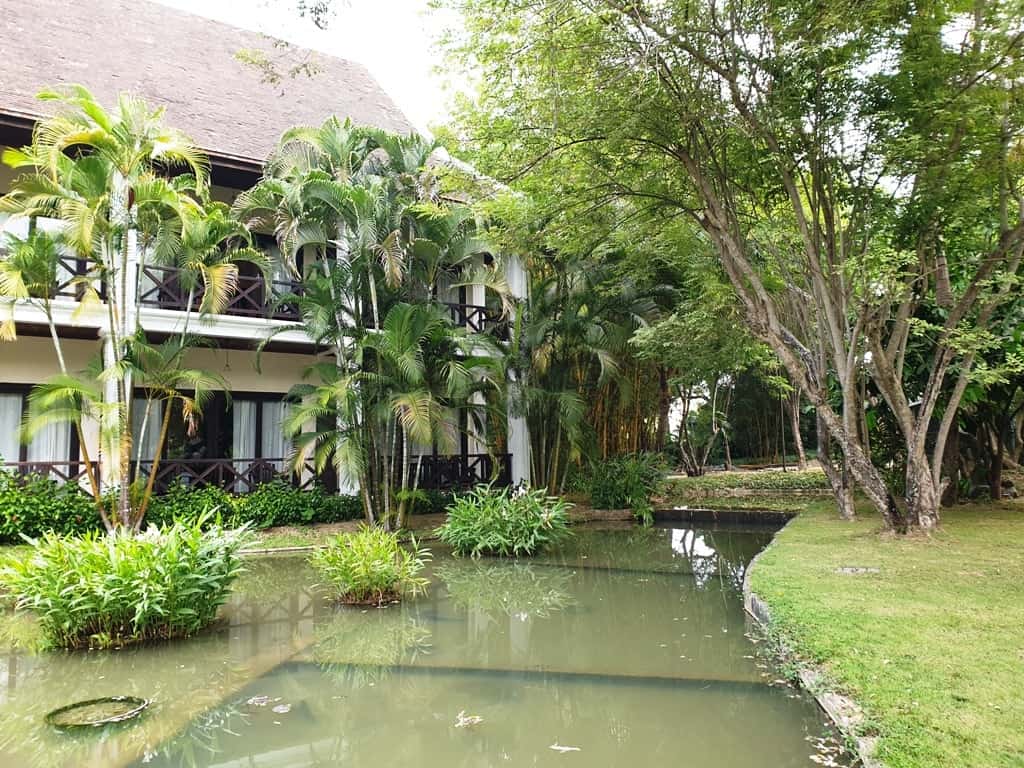
The Villa Santi Resort and Spa is the more luxurious part of the complex which comprises of Deluxe Rooms, Suites and Villas. These rooms have been designed with comfort in mind, with large double beds (mosquito net included), deep bathtubs, and spectacular views of the countryside.
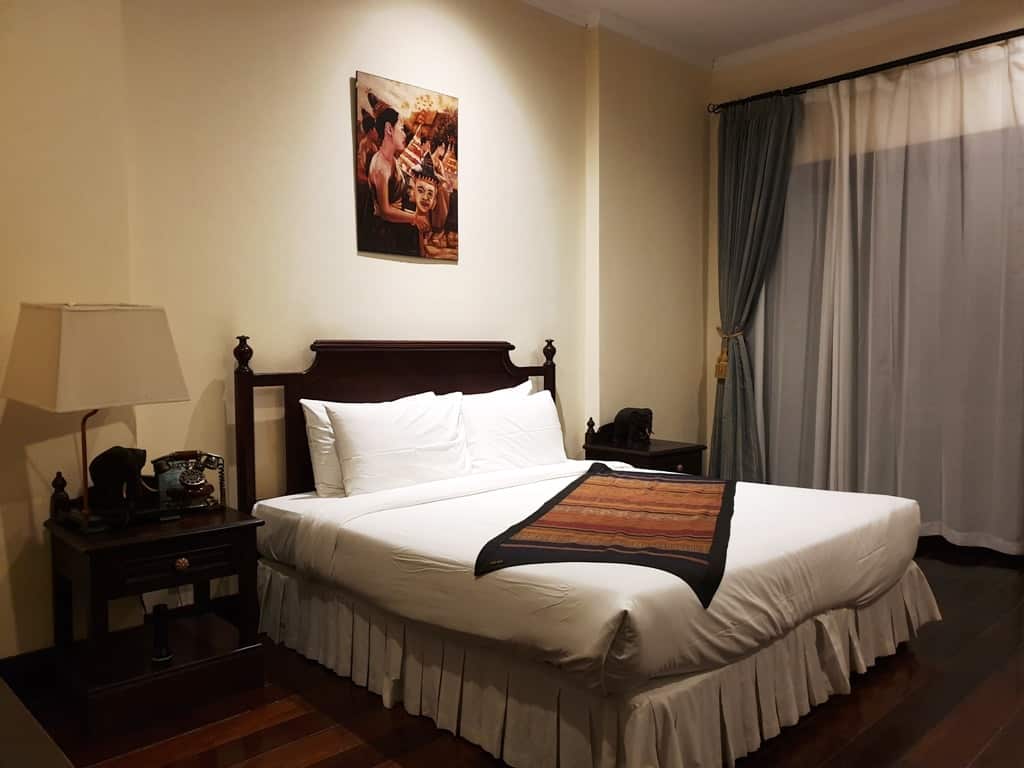
The suites and villas also boast spacious lounge areas with sofas, dining tables, and additional televisions as well as having private balconies or verandas from which you can enjoy the views. Guests are offered complimentary bottled water, a daily fruit basket, and plush bathrobes and slippers to make your stay even more luxurious.
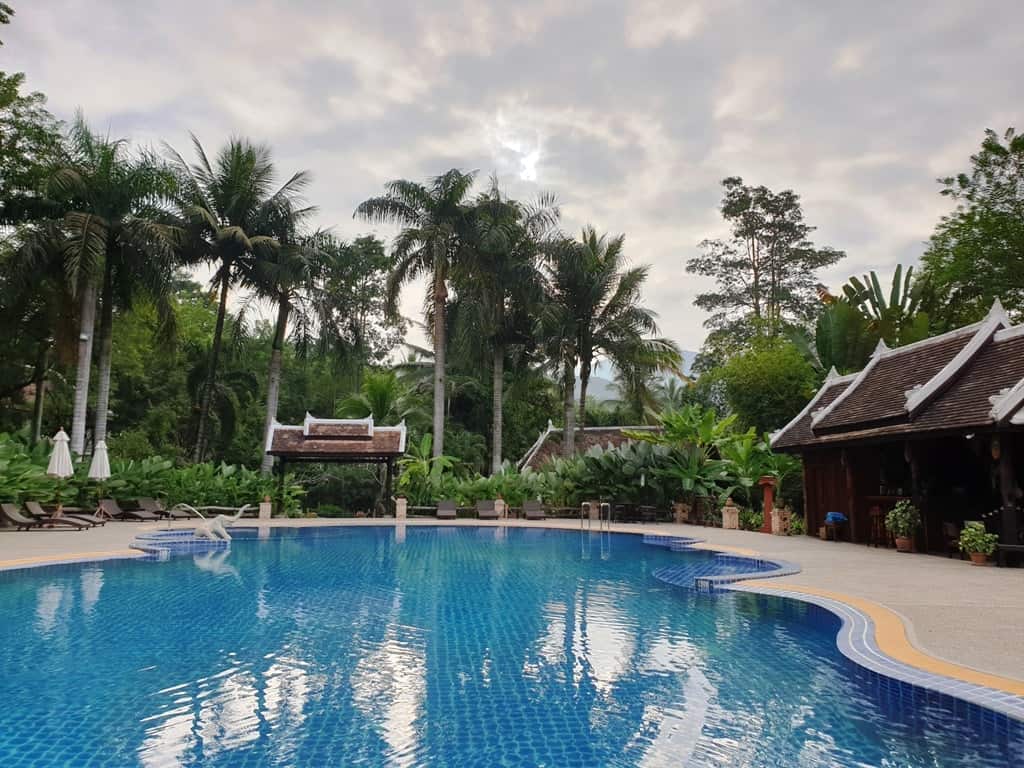
The Villa Santi Resort and Spa also features a tranquil wellness area that offers guests the space to relax and rejuvenate with a range of face and body treatments available. When not indulging in spa treatments, guests can dine at the on-site Torseng Restaurant, enjoy drinks at the Sakuna Bar or unwind in the swimming pool which also features an additional pool bar where you can grab a cocktail to sip in the sun.
Click here for more information and to book your stay.
The Villa Santi Hotel is the smaller part of the complex with just 20 designer rooms, housed in a century-old royal mansion in the center of Luang Prabang. Guests can choose between Deluxe Rooms, Junior Suites, and the Royal Suite, each of which offers comfortable beds and quality in-room facilities. The suites are larger and more spacious and feature additional lounge and dining areas for added comfort and convenience.
Guests staying at the Villa Santi Hotel can enjoy dinner at the Princess Restaurant, drinks at the Lobby Bar and can cool down in the on-site Elephant Plunge Pool in the garden.
Click here for more information and to book your stay.
By now you should have more of an idea of why so many people visit the stunning city of Luang Prabang and know what you should do, where you should stay and when you should travel to have the best experience.
Let me know if you’ve been to Luang Prabang in the comments below!
You might also like:
3 days in Luang Prabang
A 5 -day Cambodia itinerary
2 days in Siem Reap
2 days in Phnom Penh
A 10 day Vietnam itinerary
2 days in Ho Chi Minh
4 days in Hanoi
2 days in Hoi An
One day in Hue

